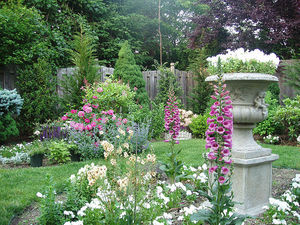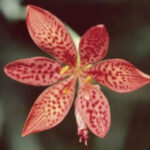Vinca, (Apocynaceae from the Dogbane Family) also known as myrtle, are usually planted in flower gardens as border plants. Vinca plants are hardy evergreen perennials with thin stems that are clustered at stem terminals. The leaves are varying in color from dark green, creamy white, silvery-white, gold or yellow variegation. The five petal flowers are usually blue-purple in color, although some are reddish lavender or white. The flowers appear in mid-spring and they continue to sporadically appear through the summer and into fall.
We have vinca plants growing in a wheel underneath the clothesline. It has been growing in this location for over 7 years and it has nicely spread out and filled in bare places. The vinca plant is often neglected, relying on rain to water it, but that doesn’t bother the vinca at all.
People living in South Dakota, zones 4, can grow vinca in sunny areas. But for people living in zones 7 through 8, the myrtle or vinca plants can grow well in shady areas. Myrtle or vinca plants can grow 6 to 8-inches in height and can spread up to three feet. Vinca is a good plant to grow. Not only are they perennials, but they don’t require much care and few bugs or diseases bother them.
As the vinca grows, it spreads and fills in the area. Every place that the nodes touch the soil, they will send out roots into the ground. This plant is grown in areas to help control erosion on slopes. Once the vinca are established, it smothers out weeds so you don’t have to pull them.
How to Grow Vinca
If you want to include vinca in your garden you’ll need to prepare the flower bed. Pull all the weeds growing. Don’t use an herbicide to kill them because it may also hurt your vinca. Dig or till the top 12 inches of soil with a garden fork or tiller. Add a 2 to 3 inch layer of compost over the soil and incorporate this into the soil.
Dig the holes in the soil with a trowel. Keep the holes the same depth as the rootball, but make each hole twice as wide as the container. Space each hole 12 to 15 inches apart. Pop the plant out of the container and insert the rootball into the hole. Fill in the hole with amended soil and then firm the soil around the vinca with your hands. Do not bury the plants any deeper than they were originally growing in the container.
Place 2 inches of mulch over the top of the ground around the newly planted vinca. The mulch helps keep the ground moist and the weeds under control. Mulch also helps control the water from splashing up from the ground onto the plant’s leaves, which can transfer fungal disease. When the vinca fill in the area, you won’t need to mulch the ground any longer.
Water the vinca plants often through the first season. After the vinca are established, water when the ground is dry or the area is in drought conditions.
Sources:
Ground Cover: Vinca Minor
South Dakota State University: Selecting Perennial Flowers for South Dakota




